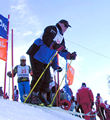|
Story
by Randy H. Milgrom
Photography by Bob Garypie and
Peter Ottlakan
Triumph
Trumps Troubles
On Monday morning, Tina Corbett
of Team USA was heading into the second-from-last turn in
the Giant Slalom competition with a sizable lead. She was
flying.
“I just said, ‘Come on! Back it down a little for these last
two and you’ve got it, easily,’” laughs her husband, Tim,
who has accompanied Tina to Nendaz from their home in Durango,
Colorado, where they both regularly ski at even higher altitudes.
But it was not to be. She came careening toward that second-to-last
gate and sent it soaring, knocking it nearly off the side
of the slice of mountain reserved for the Giant Slalom course
run. Disqualified.
So this morning would be different. Though she says she definitely
approached the run more conservatively, Tina also admits it
was a “really, really hard course.” But this is obviously
an overly modest assessment, since her graceful, criss-crossing
path down the slope was rapid enough to earn her a silver
medal.
Bouncing
Back
Her performance was not surprising, though, since bouncing
back is nothing new for Tina. She was “very fit, very healthy”
until 1986, when suddenly at the age of 26 she became very
sick with lupus disease. The next ten years were “pure hell,”
she says, with constantly aching muscles and other pains,
as well as various problems affecting her kidneys. In 1992,
she had to be flown to Denver, with bleeding in her lungs.
Following complete kidney failure, she waited, on dialysis,
for more than three-and-a-half years – until finally, about
five years ago, she received her new kidney. Tina describes
this horrendous period of waiting as “pretty much just an
existence.”
Tina had to take a break from skiing when she first got sick
– and she has since had both her hips replaced due to the
doses of prednisone she used to combat her illness. But she
had been skiing since she was 14 – including a fair amount
of racing – so following her transplant she returned to her
beloved sport with a vengeance. She was disappointed when
she realized she found out about the Transplant Games too
late to attend the Winter Games in Utah in 1999 – especially
since Snowbird is so close to her home.
But Tina is unfortunately also familiar with disappointment
– both small and large. She once wrote to her donor’s family
through the local donation coordination center in Colorado
but never received a response. Though she and Tim have learned
her donor was a woman from Michigan about Tina’s age, they
would like to know more than that.
What’s
Next?
With both her Giant Slalom troubles and her Slalom triumphs
well behind her, Tina wasn’t thinking about anything other
than the Parallel Slalom event to come. Though there was some
vague discussion floating around her about the next winter
Transplant Games, the only trip she seemed capable of thinking
about was the bus ride up to the tram stop in Nendaz – and
whether it would deliver her there on time for the start of
her next race. Later – with her most immediate source of anxiety
quelled – Tina mentioned this: just before she left for Switzerland,
she was told her kidney “may be in chronic rejection.”
“I’ve got a lot of doctors to visit when I get home” she
sighed.
But Tina has overcome a lot of difficulties before, so she’ll
do it again. At this moment, the only thing she wants to think
about is flying down this mountain just as quickly as she
can.
And that’s enough to think about for now.
|






















